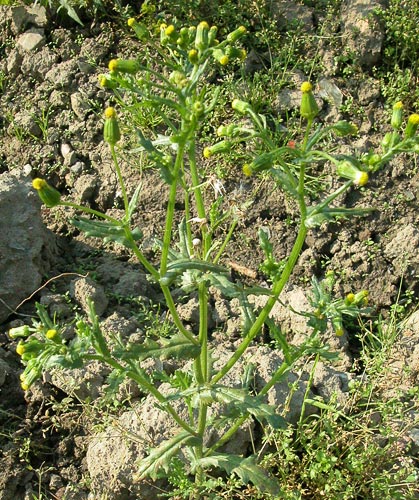Weeds
Senecio vulgaris L. - Common Groundsel.
Systematic position.
Family Asteraceae, genus Senecio L.Biological group.
Spring annual or wintering weed.Morphology and biology.
Plant grows 12-40 cm tall, bare or pubescent, slightly pulpy. Stalk upright, more or less branchy. Lower and radical leaves elongate-scapular, narrowed base, with short peduncle, indented along margins, early withering, 2-10 cm long and 0.5-2.5 cm wide. Middle stem leaves oblong or lanceolate, deep emarginate-pinnatilobate, with irregularly dentate or entire lobes, sharp above, narrowed base, sessile, 3-11 cm long and 0.5-2 cm wide. Anthodia bell-shaped, 6-8 mm long and about 5 mm wide, cylindrical, located at ends of stalk and branches. Pedicles 1-3.5 cm long, frequently inclined. External leaflets are involucre lanceolate, 2-7 in number, with black tips, 2-6 times shorter than internal leaflets. All flowers are tubular. Hemicarps gray or dark brown, oblong, 2-2.5 mm long and 0.4-0.5 mm wide, with longitudinal, sometimes golden-yellow ribs, slightly narrowed toward both ends. Furrows between ribs are covered with short accumbent hairs. Flowering occurs in July-August, fructification occurs in August-November. One plant can produce 1400 to 20,000 hemicarps. Weight of 1000 seeds is 0.25 g. The plant propagates by seeds that are distributed with the help of the wind. The minimum temperature for seed germination is 2-4°C, optimum is 16-24°C. Shoots appear in March-May, and at the end of summer and the beginning of autumn.Distribution.
The European part of the USSR, the Caucasus, Western and Eastern Siberia, the Far East, Central Asia (seldom), Europe, Scandinavia, the Mediterranean, the Western Tibet and The Himalayas, Northern Mongolia, Northern America (adventive), Asia Minor, Northern Africa, Iran, Japan, Northeast China, Korea.Ecology.
Plant prefers fresh, well humidified, rich humus and nitrogen soils. It is a weed of crops in the forest zone mainly, a ruderal weed in steppe and desert zones, found near habitations, along roads, on railroad embankments.Economic significance.
It is a weed of grain, vegetable, and tilled crops (especially carrots), also gardens, hop-gardens, vineyards. Control measures include treatment of fallows, pre-seeding cultivation, crop rotation and application of herbicides.Reference citations:
Anonymous. 1996. Weeds on sugar beet. Berlin: Hoehst Shering AgrEvo Gmbh. 479 p. (In Russian)Chesalin G.A. 1975. Weeds and their control. Moscow: Kolos. 256 p. (In Russian)
Keller B.A., ed. 1935. Weed plants of the USSR. V. 4. Moscow-Leningrad: AN SSSR. 416 p. (In Russian)
Komarov, V.L., ed. 1959. Flora of the USSR. V. 25. Moscow-Leningrad: AN SSSR. 557-558 p. (In Russian)
Nikitin, V.V. 1983. Weeds in the flora of the USSR. Leningrad: Nauka. 454 p. (In Russian)


